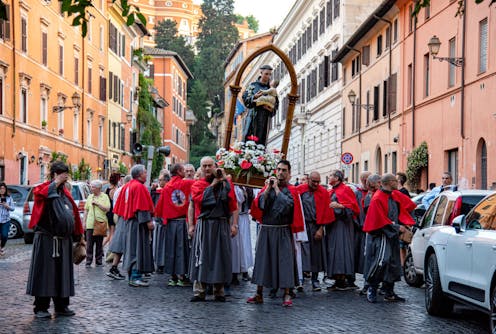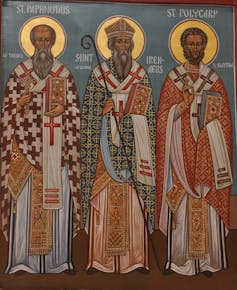Why are some Roman Catholic saints called doctors of the church?
Saints are recognized for exceptional virtue and faith. But some also are commemorated for their scholarship.

In January 2022, Pope Francis bestowed the title doctor of the church on St. Irenaeus of Lyons, a Christian bishop who died about A.D. 200 For centuries, Christians in both the Roman Catholic and Eastern Orthodox churches have venerated him as a saint.
As a specialist in medieval Christianity, I found myself reflecting on the meaning of this title and why is it important today. There are over 10,000 saints recognized by the Roman Catholic Church. However, only a few dozen of them have been named a doctor of the church, an honorific that recognizes the importance of their teaching, scholarship and writings.
Early saints
In early centuries, Christians executed in the Roman Empire for refusing to renounce their faith – called martyrs, meaning witnesses – were commemorated by their local communities and referred to as holy: sanctus or sancta, in Latin. The graves of these saints were considered holy places, and believers would visit them to pray.
Later, those who had been imprisoned but not put to death were honored by other Christians because of their outstanding courage and strength of faith. Their communities called them confessors because they professed their faith.
Other titles were eventually added to distinguish additional categories of saints, such as bishop, priest or widow. Even children were, and still can be, approved for saintly veneration.
For the first thousand years, holy men and women were venerated as saints regionally, usually with the approval of the local bishop. Later, the popes took charge of officially proclaiming saints, and a formal process developed for examining the applications, or causes, of saintly candidates proposed by regional bishops or other religious groups.
Scholars and teachers
Over time, a handful of Christian saints and teachers became especially renowned for their writings or scholarship. A few from the early centuries of the church were recognized as important teachers, or fathers of the church, by both Western and Eastern churches – which finally split into the Roman Catholic and Eastern Orthodox churches, respectively, in the 11th century.
In the Middle Ages, other saintly teachers in Western Europe were acclaimed specifically as doctors of the church by the authority of popes. Some revered theologians began to be known as doctor of a specific idea or characteristic. For example, contemporaries of the medieval theologian St. Albert the Great, who died in 1280, came to refer to him as the “universal doctor” because of the wide range of topics he covered in his writings. Even one or two of the earlier fathers of the church acquired these additional titles, such as St. Augustine. This North African saint, one of the most influential Christian theologians, died in 430 and became known as the “doctor of grace” because of his theories about grace as a free gift of God. In several regions, local communities gave similar titles to other respected figures even if they were not officially recognized as saints.
Formal lists of these doctors were compiled and expanded during the 16th through 20th centuries. Today, the Roman Catholic Church lists 37 saints officially recognized by papal pronouncement as doctors of the church.
Until after the Second Vatican Council, which met from 1962 to 1965 and initiated significant modern reforms in the church, all doctors of the church were men – usually bishops or priests. In the following decades, that changed.
Today the Catholic Church recognizes four saintly and learned women from several different centuries for their theological and spiritual writings. They include the 16th-century Spanish mystic Teresa of Avila and the 12th-century German abbess Hildegard of Bingen, an expert on herbal medicine and botany as well as liturgical drama and music.

‘Doctor of unity’
So, why add another doctor now? St. Irenaeus was already recognized as one of the early fathers of the church. Born during the 2nd century in what is now Turkey, he served as bishop of Lyons in what is now France – moving from one side of the Roman Empire to the other.
He wrote forcefully against a philosophical and religious movement called gnosticism – from the Greek word gnosis, or knowledge – which he saw as a heresy threatening to separate Christians from beliefs handed down by Jesus’ apostles. Gnostic Christians taught that the physical world was created not by God, but by a lesser spiritual being, either in error or out of malice. They rejected the traditional Christian beliefs that material reality and the human body were fundamentally good and held that the body was a worthless obstacle to achieving spiritual perfection.
[3 media outlets, 1 religion newsletter. Get stories from The Conversation, AP and RNS.]
Irenaeus argued against the gnostics, insisting God created both material and spiritual reality and that both were rooted in God’s goodness. His critique of the gnostic view of Christian teaching reaffirmed the importance of the teaching of the apostles, based on the writings of the Old Testament prophets and the four Gospels of Matthew, Mark, Luke and John. So Irenaeus’ teaching was valued by later theologians working to strengthen the church’s definition of orthodox beliefs.
In 2021, members of the St. Irenaeus Joint Catholic-Orthodox Working Group, an unofficial group of theologians seeking to enrich mutual understanding, met in Rome. During that meeting, Pope Francis stated his intention to officially declare the saint a doctor of the church. As the pope later noted, Irenaeus’ life and teaching serve as a bridge between Eastern and Western Christianity. In his own life, he served churches in both traditions, and, despite their individual differences, strove to keep them united against divisive teachings.
Because of the influence of his theology and the example of his ministry, St. Irenaeus will be one of those doctors of the church, like St. Albert the Great, to be given a distinctive honorific title: “doctor of unity.”
At a time when disease, environmental disasters and wars threaten to divide Christianity and the world, many believe that a saintly “doctor of unity” may well inspire a more hope-filled future.
Joanne M. Pierce does not work for, consult, own shares in or receive funding from any company or organization that would benefit from this article, and has disclosed no relevant affiliations beyond their academic appointment.
Read These Next
The world risks forgetting one of humanity’s greatest triumphs as polio nears global eradication − 7
Polio may finally be defeated in the next 5 years. Will the world recognize what an extraordinary achievement…
People are getting their news from AI – and it’s altering their views
Even when information is factually accurate, how it’s presented can introduce subtle biases. As large…
Medieval peasants probably enjoyed their holiday festivities more than you do
The Middle Ages weren’t as dreary and desperate as you’d think, and peasants often had weeks of…





